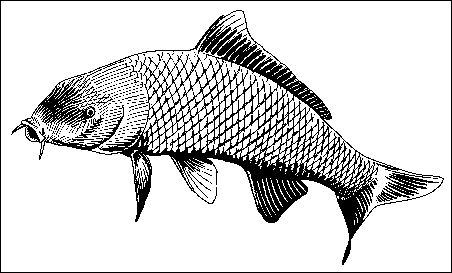

"Ah, he's just one of those bottom-feeders!" Perhaps you've made or heard such a comment before, said in frustration. But some of our most remarkable creatures are just that—bottom feeders!
Carp have been associated with man perhaps longer than any other fish species. Natives of Asia, they have now been introduced throughout much of the world, living in fresh-water streams and rivers. Many of us may think of carp as being "muddy" fish, and rightly so—usually they suck up food from the mud, and they swallow some mud in the process. Once the edible material is digested, the rest is simply excreted.
One of the most fascinating adaptations of this fish is that it can eat
hard-shelled creatures, like snails, despite not having teeth as we know them. Carp
grind hard prey using tooth-like structures in their throats, then spit out the hard
stuff and swallow the flesh. Occasionally they do come to the surface to feed, and they
make a characteristic slurping sound as they gulp air and water, along with their prey.
Perhaps their mothers should have taught them better manners!

Listen to the Audio (mp3 format) as recorded by KTEP, Public Radio for the Southwest.
Contributor: Kodi R. Jeffery, Centennial Museum, University of Texas at El Paso.
Desert Diary is a joint production of the Centennial Museum and KTEP National Public Radio at the University of Texas at El Paso.

A small, dead carp. Image from a preserved specimen.

An artist's rendition of a carp. Drawing © 1999 by Zackery Zdinak.
Images of pharyngeal teeth.
Page, L. M., and B. M. Burr. 1991. Freshwater Fishes. Peterson Field Guides, Houghton Mifflin Co., Boston, 432 pp. See page 63 and plate 14.